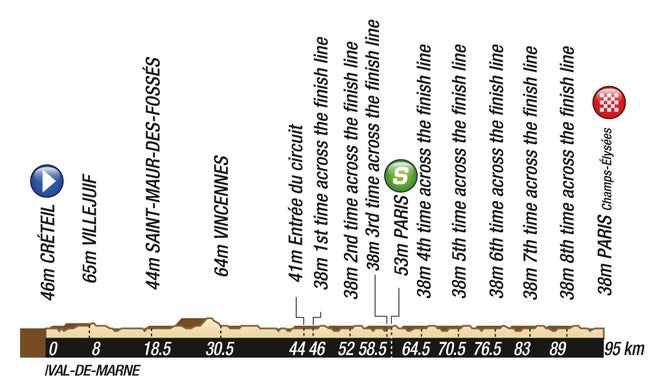Heading out the door? Read this article on the new Outside+ app available now on iOS devices for members! Download the app.
Analyzing and rating all 21 stages
Last year’s Tour de France was headlined by a mountaintop finish on the Col du the Tourmalet (won by Luxembourg’s Andy Schleck over Spain’s Alberto Contador) to mark the centennial of the Tour’s first crossing of the Pyrénées. This year’s race, starting on Saturday, celebrates 100 years of racing through the High Alps, culminating with a stage to the top of the Col du Galibier — which, at 8,678 feet (2,645 meters) elevation, will be the highest stage finish in Tour history.
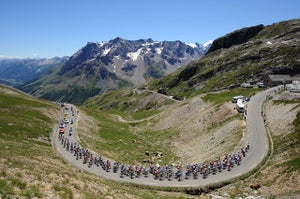
That stage comes three days from the finish of the 98th Tour, which covers 3,443km (2,108 miles) over 23 days in July. The three stages in the Alps, along with the penultimate day’s individual time trial at Grenoble, will decide who wins this year’s Tour, but in a race that is often won by mere seconds the race can be lost on any of the 21 daily stages.
So here’s a detailed look at all the stages with the scoop on what to look for each day and my rating of each day’s importance to the overall, or general classification (GC) contenders. A one-star rating indicates the least influence on the race for the leader’s yellow jersey, while five stars is given to stages that have the very highest importance.
This Tour’s Grand Départ (the “Great Start”) is in the rural Vendée region of western France. As when the race started here in 1993 and 1999, the teams will be presented to the public on Thursday evening (June 30) prior to a spectacular nighttime sound-and-light show at the lakeside medieval castle of Le Puy du Fou. But the true fireworks begin two days later when the opening stage gets underway besides the gray waters of the Atlantic Ocean.
The 198 riders (22 teams of nine riders each) mount their bikes at the fishing port of Fromentine before heading off on a processional ride of 13.5km across the island of Noirmoutier and the Passage du Gois (pronounced “gwah”), the infamous 4.5km-long paved causeway that’s flooded at high tide. They will stop at the causeway’s eastern exit where, at the lowest point in the Vendée, the Tour’s starting ceremonies will be held. A band will play the Marseillaise and a VIP will cut the tricolor ribbon stretched in front of the peloton before they roll away behind the race director’s red Skoda sedan. Then, 2km later, he’ll wave the official starting flag to get the 2011 Tour de France underway, almost an hour after leaving Fromentine.
July 2 Stage 1: Passage du Gois to Mont des Alouettes, 191.5km (119 miles)
With the time-consuming protocol out of the way, the peloton will be keen to get on with the racing. This is one of the flattest stages of the Tour, so expect speeds to be high despite likely crosswinds off the ocean. The sprinters’ teams will be eager to keep the peloton together until the uphill straightaway at Avrillé (87km, 54 miles) for the very first, new-format intermediate sprint.
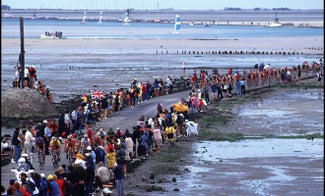
This daily mid-race sprint, with a hefty allocation of points for the best-sprinter’s green jersey competition, is an experiment that should yield spectacular results, especially on a stage like this one when the pure sprinters are disadvantaged by an uphill finish at the end of the day. Expect breakaways to form on the hillier second half of this stage but the field is likely to come together in the final hour after the fast downhill run into Les Herbiers. Here, the riders have to negotiate eight roundabouts on the town’s ring road prior to what should be an exciting finale.
The last 4km is all uphill, shallow at first before hitting a steady 5-percent grade on wide roads where the wind could scupper the chances of a solo attacker. The finish line is at the top of the Mont des Alouettes (”Mount of the Larks”) 748 feet (228 meters) above sea level, not far from the highest point in the Vendée. The strongest sprinters (rather than the fastest) will likely contest the stage win — and the Tour’s first yellow jersey.
THE SCOOP: GC contenders will have to be wary of getting caught out by splits in the peloton caused by (1) the quick succession of roundabouts in the last 6km, (2) the high speed of the climb to the finish and/or (3) the likely crosswinds.
OVERALL RATING: **
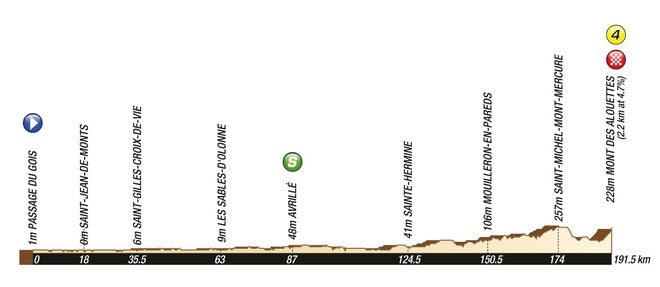
July 3 Stage 2: Les Essarts team time trial, 23km (14.3 miles)
The team time trial (TTT) is a stage in which each of the 22 teams starts separately at seven-minute intervals, with the fastest time taking the win. Most importantly, the team time (measured on its fifth man across the line) counts on the individual GC, so the yellow jersey is almost certain to go to the first rider across the line in the day’s fastest team. The course is a flat 23km team time trial on a straightforward, triangular course at the town of Les Essarts, population 5,000. Riding fast in strong winds will be each team’s goal, with the short distance designed to keep the time gaps small (probably less than 10 seconds between the top three teams and maybe 90 seconds to the slowest one) and ensure that the first week’s GC is not locked up by the TTT-winning formation.
THE SCOOP: All the GC contenders hope that their team is strong enough to take a top-five or at least a top-10 finish; otherwise, if they finish more than a minute back, their Tour-winning chances will be greatly reduced.
OVERALL RATING: ***
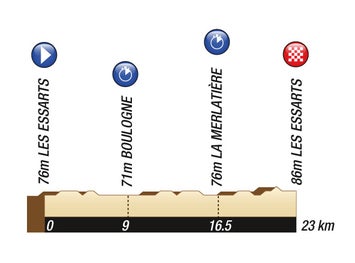
July 4 Stage 3: Olonne-sur-Mer to Redon, 198km (123 miles)
This is a stage that should end up favoring the sprinters, like the Manxman Mark Cavendish, American Tyler Farrar or Italian Alessandro Petacchi. The course is the flattest of the Tour, heading north from the Vendée region into Brittany, paralleling the Atlantic coast before crossing the Loire River estuary on the 216-foot high St. Nazaire Bridge — which is the day’s only climb, given the lowest, category 4 designation. If there are strong crosswinds the race could break up in the remaining 55km (34 miles) that the peloton will probably cover in one hour. The race passes through the town of Pontchâteau on its way to a flat finish in Redon.
THE SCOOP: Everyone will need to be wary of two tricky turns, a right uphill 270-degree loop from a highway with 6km to go and a sharp right just outside 3km; if there is a crash on either turn riders could lose a bunch of time because time lost from crashes or mechanical problems are only cancelled out for incidents inside the final 3km.
OVERALL RATING: *
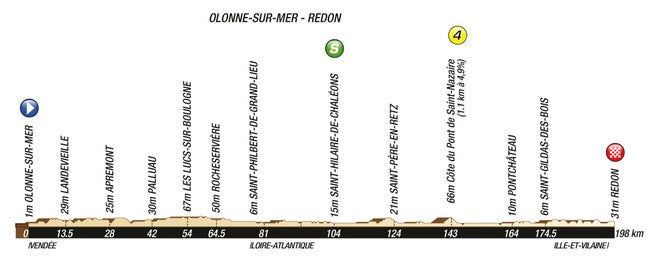
July 5 Stage 4: Lorient to Mûr-de-Bretagne, 172.5km (107 miles)
This stage is definitely not one for the sprinters. The start in Lorient is only 70km from the finish at Mûr-de-Bretagne, but the route of this fourth stage travels an extra 100km on a loop that takes in lot of short climbs through central Brittany before finishing atop the infamous hill at Mûr-de-Bretagne that the locals call Brittany’s L’Alpe d’Huez because so many fans line its slopes on race day. This finishing climb opens with a straight kilometer at a 10-percent grade, including two 15-percent pitches, and eases to 5.5 percent, then 2.4 percent for the final 500 meters.
THE SCOOP: Expect to see the GC riders’ teammates pulling their leaders toward the head of the bunch in the final kilometers before reaching a short hill into the town of Mûr-de-Bretagne 4km from the line. Vital seconds will be lost by those not starting the final climb in good position.
OVERALL RATING: ***
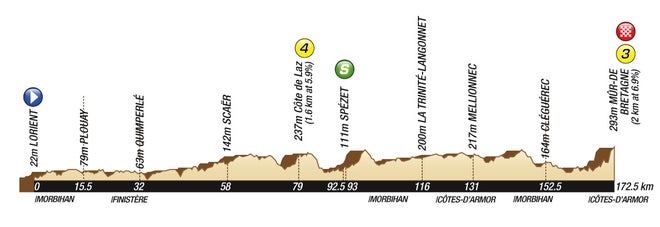
July 6 Stage 5: Carhaix to Cap de Fréhel, 164.5km (102 miles)
The main features of this medium-distance stage are the 45 communities it passes through (increasing the likelihood of crashes) and the winds that almost always blow across the exposed coast of northern Brittany. The finish near Cap Fréhel, a rocky headland jutting into the English Channel (the French call it La Manche), is where Bjarne Riis’s CSC team split the race apart in crosswinds on a stage to St. Brieuc in 2004. This year’s route is in the opposite direction, with the race passing through St. Brieuc 50km from the end, but expect similar tactics from Riis (who now directs Contador’s Saxo Bank team).
THE SCOOP: A short, sharp hill 3km from the finish followed by a fast downhill and a slightly uphill final kilometer with frequent turns could favor a late attack and catch out the sprinters (and a few GC contenders).
OVERALL RATING: *
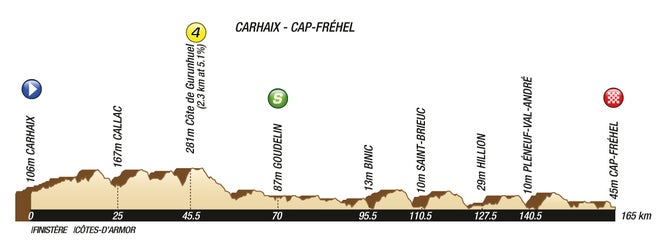
July 7 Stage 6: Dinan to Lisieux, 226.5km (140.7 miles)
This longest stage of the 2011 Tour is also likely to be one of the fastest because it heads east with the prevailing winds out of Brittany along the Channel coast and across the rolling hills of Normandy. The finish at Lisieux features a significant climb past its massive Ste. Thérèse basilica, 2km from the finish, featuring a 10-percent pitch midway up the 1.3km, 6.3-percent grade.
THE SCOOP: The sprinters’ teams are likely to let a breakaway form after the intermediate sprint at Vassy, some 100km from the finish. Given the length of the stage, the break should stay away; but GC contenders will still need to be wary of losing time when the peloton splits on the climb to the finish.
OVERALL RATING: **

July 8 Stage 7: Le Mans to Châteauroux, 218km (135.5 miles)
This is another long stage, but much flatter, heading south from the Loire valley to a flat finish in Châteauroux — where Mark Cavendish won his very first Tour stage three years ago. There are some sharp turns and a roundabout in the final 5km, but the lead-out trains set up by the teams of the leading sprinters should prevent any late attacks from succeeding.
THE SCOOP: This stage will almost certainly provide the last (and best!) mass sprint finish of the Tour’s opening week, though the overall contenders will again have to avoid crashes (on two sharp turns and the roundabout) before reaching the 3km-to-go marker.
OVERALL RATING: *

July 9 Stage 8: Aigurande to Super-Besse, 189km (117.5 miles)
As it did in 2008, this year’s Tour will head into the hilly terrain of the Massif Central with an almost identical stage from Aigurande to a summit finish at Super-Besse. This is where Riccardo Riccò (later disqualified for doping) sprinted home ahead of Alejandro Valverde (who is suspended this year for another doping offense) and Cadel Evans. One difference is that the finale is preceded by a much harder climb, the Cat. 2 Col de la Croix St. Robert (6.2km at a 6.2-percent average grade), followed by 19km of winding back roads before the last climb begins in the town of Besse.
THE SCOOP: The climb to the finish is in two parts: a 2.5km haul out of Besse town at almost 7-percent grade and, after a downhill section, a 1.5km kicker to the line at almost 8 percent. It’ll suit a mixture or GC contenders and those seeking stage wins at hilltop finishes.
OVERALL RATING: ***
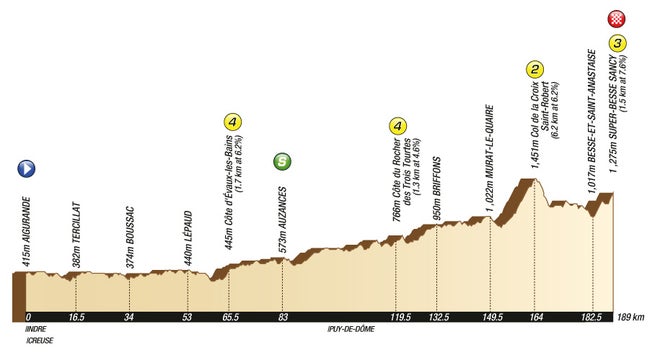
July 10 Stage 9: Issoire to St. Flour, 208km (129 miles)
This is the first day of serious climbing, with almost 12,000 feet (3,660 meters) of elevation gain in a 208km stage that will mean almost six hours in the saddle. It’s similar to a stage in 2004 that also crossed a slew of long climbs through the same mountain range when Frenchman Richard Virenque finished solo in medieval St. Flour five minutes ahead of a 70-strong peloton. This year, the group will be much smaller due to the quick succession of the Cat. 2 Puy Mary, Perthus and Prat de Bouc climbs within a 40km stretch that comes only 54km from the uphill finish.
THE SCOOP: All the GC favorites’ teams will need to be ready to respond to dangerous breakaways, especially on the narrow, undulating back roads in the last 20km of this long (and perhaps very hot) day.
OVERALL RATING: ***
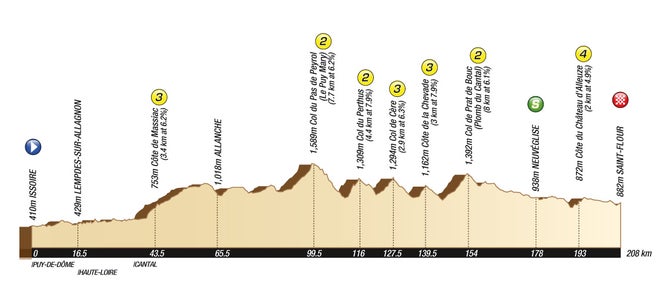
July 11 Rest day at Le Lioran Cantal
The 22 teams are staying for two nights at 20 separate hotels in 14 different towns scattered around the Cantal region of the Massif Central. The athletes will have plenty of hills to discover on their traditional two-hour rest-day rides to keep their legs turning.
July 12 Stage 10: Aurillac to Carmaux, 158km (98 miles)
After the first rest day, the Tour will continue with another stage in the Massif Central, but on a more rolling than hilly course. After the intermediate sprint at Maurs early in the day, expect multiple attacks over this stage’s four categorized climbs, the last of which, 10km from the line, offers a chance for a strong rider to break clear of the pack.
THE SCOOP: Everyone will have to be wary of the final kilometers into the old coalmining town of Carmaux. The two 90-degree corners and three curving turns in the final kilometer, following a fast 3km downhill run into town, will present extra challenges for the sprinters and a high chance for crashes.
OVERALL RATING: **
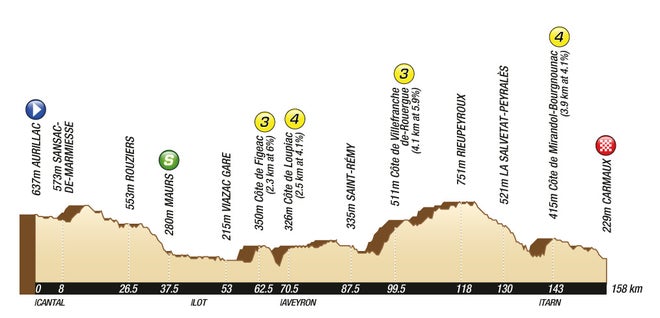
July 13 Stage 11: Blaye-les-Mines to Lavaur, 167.5km (104 miles)
Despite this stage coming halfway through the Tour on a course through the hilly Tarn-et-Garonne area, between the Massif Central and the Pyrénées, it’s made for sprinters. Both the intermediate sprint at Gaillac (85km) and the finish at Lavaur two hours later are on straight, wide streets after long downhill runs.
THE SCOOP: After this one, only two other stages give sprinters a chance of winning (at Montpellier in four days’ time and in Paris), so expect Cavendish, Farrar and Petacchi to be battling for the green jersey points in Gaillac and the stage win in Lavaur.
OVERALL RATING: *
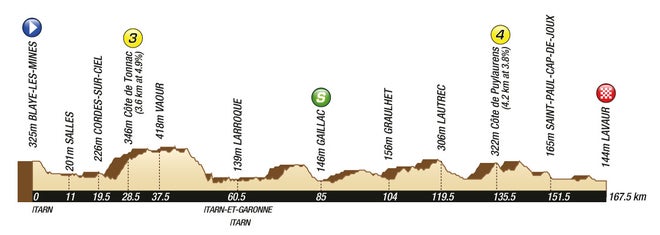
July 14 Stage 12: Cugnaux to Luz-Ardiden, 211km (131 miles)
After a rest day and two relatively simple stages, this first excursion into the high mountains of the Pyrénées will come as a shock to most of the field. It’ll be six hours long with almost 13,000 feet (3,900 meters) of elevation change, ending with three giant climbs: the 10km Cat. 1 Hourquette d’Ancizan as a warm-up; the familiar 17km hors-cat (above-category) Tourmalet; and the 13km hors-cat finale to the mountaintop finish at Luz-Ardiden.
Being July 14, when they celebrate Bastille Day in France, the home fans will be hoping for a French stage winner. In fact, since World War II, only 15 French riders have won a Tour stage in 64 attempts. The last one to do so was David Moncoutié, six years ago; but with the yellow jersey on the line the big guns will be shooting for this prestigious victory.
THE SCOOP: Whereas Lance Armstrong vigorously targeted the first mountaintop finish in his seven winning Tours, three-time winner Contador has yet to win such a stage. There’s a chance the Spaniard will be left with very few teammates by the final climb, which would give multi-leader teams such as Garmin-Cervélo, Leopard-Trek and RadioShack an opportunity to send riders in early breakaways and force Contador’s men to chase rather than set up the defending champion for a late attack.
OVERALL RATING: *****
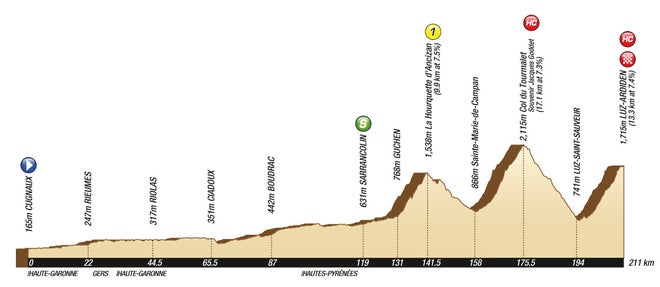
July 15 Stage 13: Pau to Lourdes, 152.5km (94.8 miles)
With the general classification fully established at Luz-Ardiden, the main contenders will be happy to have an easy day before the even more important third Pyrenean stage coming up. And though this stage climbs the more difficult side of the mythic Col d’Aubisque, a breakaway of riders low on the GC totem pole will almost certainly be well clear before then. Only 13km separates the end of the Aubisque descent from the finish in Lourdes, so a solo rider escaping on the downhill could easily win the stage. If not, two sharp downhill turns in the last kilometer might influence an eventual group sprint.
THE SCOOP: The Tour has only once held a stage finish in the pilgrim city of Lourdes. That was in 1948 after a mountain stage over the Aubisque and ended in a three-man sprint taken by that year’s eventual winner Gino Bartali of Italy ahead of two French riders, defending champion Jean Robic and a future champion Louison Bobet.
OVERALL RATING: ***
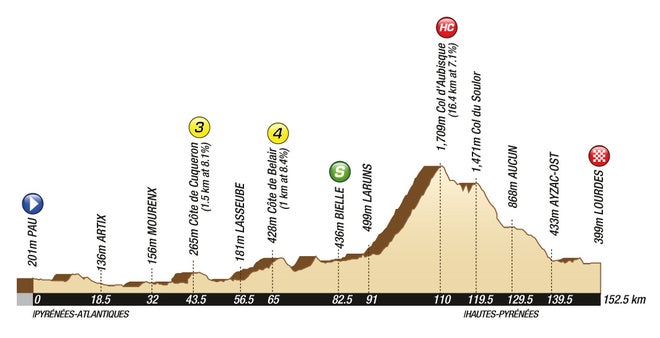
July 16 Stage 14: St. Gaudens to Plateau de Beille, 168.5km (104.7 miles)
This is one of the two toughest stages of the 2011 Tour de France, with seven major climbs, almost 16,000 feet (4,800 meters) of elevation gain and a finish atop the 16km-long Plateau de Beille that has several 10-percent pitches in its opening half. The stage is almost a blueprint of the one in 2004 when Levi Leipheimer said: “It was probably the hardest stage I’ve ever done. Little by little I ran out of gas. I was completely empty (at the end).” Leipheimer was stronger in 2007, the last time a stage finished here, conceding only 40 seconds to Contador and gaining 1:12 on Andreas Klöden and Evans.
THE SCOOP: There have been only four stages to the remote Plateau de Beille, a Nordic ski station; all four have been won by the man who’d go on to win that year’s Tour: Marco Pantani in 1998, Armstrong in 2002 and ’04, and Contador in ’07.
OVERALL RATING: *****
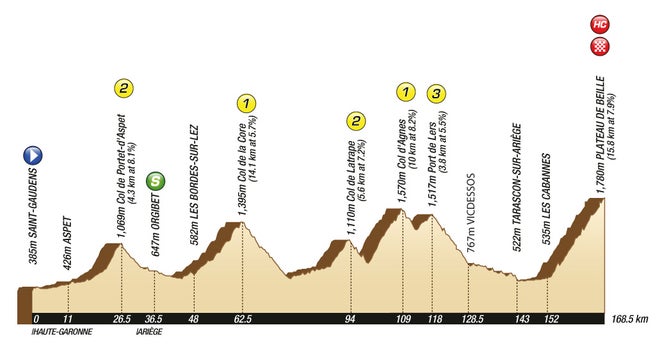
July 17 Stage 15: Limoux to Montpellier, 193km (120 miles)
Usually, the third Sunday of the Tour, is devoted to a major mountain stage or time trial, but this year’s stage is a mostly flat run out of the Pyrénées and through the Languedoc vineyards to Montpellier. The sprinters’ team will be working hard to control the early attacks — that will likely consolidate before the race passes the medieval fortifications of Carcassonne’s La Cité, 25km into the stage. And as there’s no racing the next day, the best sprinters’ teammates will be prepared to work hard for their man.
THE SCOOP: The sprinters’ goal is usually to wait and catch the breakaway in the final 10km but with this day’s intermediate sprint at Montaignac, only 46.5km from the finish, that’s where the peloton will probably regroup. Less than an hour later, after racing on 10km of wide boulevards through the Montpellier suburbs, the final sprint should be fast and spectacular.
OVERALL RATING: *
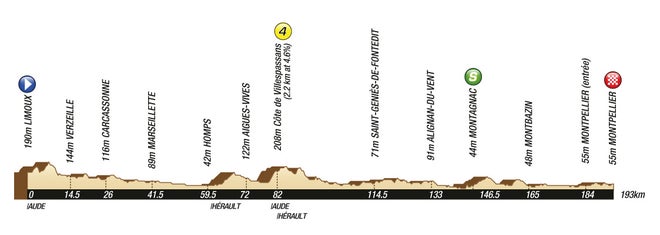
July 18 Rest day in the Drôme region
Teams will stay two nights at hotels in a dozen towns between Valence and Orange in the Rhône Valley, with Team RadioShack the only one sleeping at the next day’s start in St Paul-Trois-Châteaux.
July 19 Stage 16: St. Paul-Trois-Châteaux to Gap, 162.5km (101 miles)
This stage has a sting in the tail in the form of a 20km finishing loop that climbs the opening 4km of the Col Bayard (with some 10-percent pitches) before veering off to the Col de Manse summit, which is 1,640 feet (500 meters) above the finish in Gap. The descent via La Rochette is tricky and steep — where, in 2003, Joseba Beloki fell and sustained career-ending injuries and Armstrong cyclo-crossed down the mountainside to avoid crashing.
THE SCOOP: Even though a breakaway will probably stay clear to contest the stage win, some GC contenders will almost certainly attack on the Bayard-Manse climb that summits only 11.5km from the finish.
OVERALL RATING: **
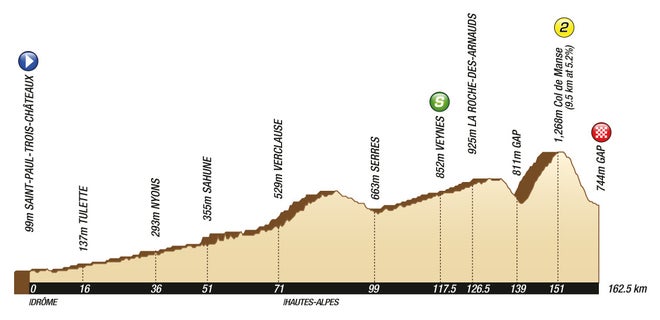
July 20 Stage 17: Gap to Pinerolo (Italy), 178km (110.6 miles)
This first of three stages in the Alps heads into Italy via the Cat. 1 climb to Sestriere, but this is more than 60km from the finish, so the real action won’t take place until the brutal Cat. 2 Colle Pra Martino. On a narrow, very twisting back road, this 6.7km climb averages 6.2 percent, but it has a 12-percent section just before a summit that’s only 7km from the line in Pinerolo. The 3km-long, switchback descent averages a vertiginous 15 percent and that’s where the stage can be won and lost.
THE SCOOP: The Pra Martino climb was used in a Giro d’Italia stage to Pinerolo in 2009 when, of the riders doing this year’s Tour, the best were Ivan Basso, Levi Leipheimer and Damiano Cunego.
OVERALL RATING: ***
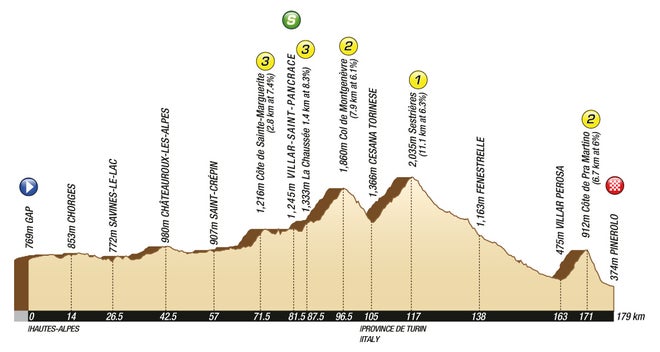
July 21 Stage 18: Pinerolo to Col du Galibier, 200.5km (125 miles)
This stage heads back into France over the mighty hors-cat Col Agnel, which at 9,002 feet (2,744 meters) is the highest mountain pass this year. The Tour has never crossed the Agnel from the Italian side, which is a climb of almost 24km, averaging 6.6 percent, but most importantly averaging 10 percent for the final 9km! The peloton will split dramatically here before a sharp descent, and this should herald multiple attacks on the following Col d’Izoard (almost 15km at 7.1 percent). Another technical downhill ends in Briançon, where the race covers a dozen kilometers in the valley before the 23km-long haul to the finish on top of the Col du Galibier — that was first scaled in the Tour 100 years ago. The stage totals a gargantuan 17,000 feet (5,180 meters) of climbing!
THE SCOOP: Besides marking this alpine centennial, at 8,678 feet (2,645 meters) above sea level, the Galibier is the highest summit finish in Tour history; and though the gradient on this southern approach averages only 5-percent, it gradually steepens to end with a 12.5-percent kicker to the line!
OVERALL RATING: *****
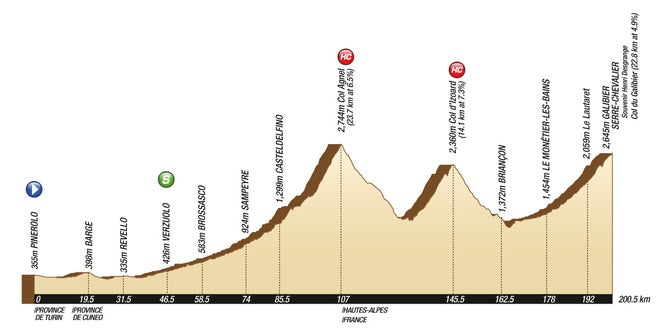
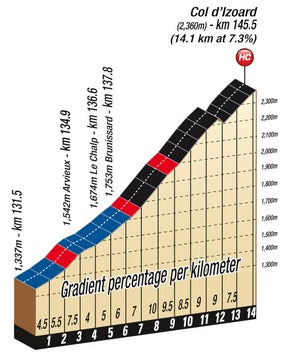
July 22 Stage 19: Modane to L’Alpe d’Huez, 109.5km (68 miles)
Don’t be fooled by the brevity of this final mountain stage. It’s less than 110km (just 68 miles) but there’s barely a kilometer of flat roads between Modane and the spectacular summit finish in L’Alpe d’Huez. After a short downhill from the start, the peloton will tackle the more difficult side of the Galibier via the Col du Télégraphe, a total ascent of 28.6km with an average 7-percent grade. Don’t expect heroics on this reverse crossing of the Galibier because the race still has to negotiate a mostly downhill run of 43km (via the Col du Lautaret) before starting the 13.8km hors-cat climb to the finish.
THE SCOOP: The only rider in this race to have won a Tour stage at L’Alpe d’Huez is Fränk Schleck, five years ago, while the last time the race came here, in 2008, the best finishers of the current field were Samuel Sanchez, Andy and Fränk Schleck, Cadel Evans and Christian Vande Velde.
OVERALL RATING: ****
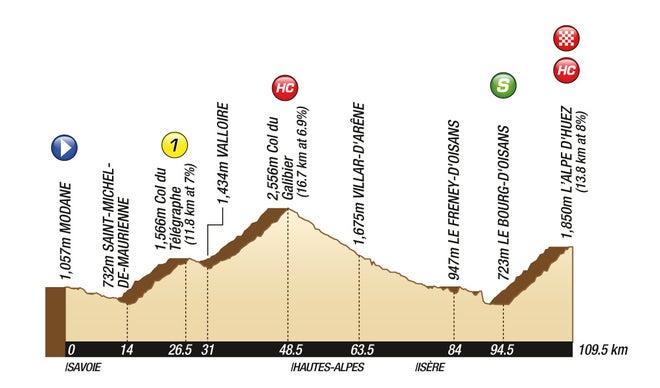
July 23 Stage 20: Grenoble time trial, 42.5km (26.4 miles)
The three demanding alpine stages should settle the destiny of the yellow jersey. If not, then this only individual time trial of the 2011 Tour should do the job. When this same hilly 42.5km circuit at Grenoble was raced in the Critérium du Dauphiné earlier this month, Germany’s Tony Martin won the stage in 55:28 (an average speed of 45.973 kph) by just 11 seconds from Britain’s Brad Wiggins. Another 1:09 back, in sixth place, came Cadel Evans, while climbers Jurgen Van den Broeck and Robert Gesink lost 2:29 and 2:38 respectively to Wiggins.
THE SCOOP: Though Martin or world TT champ Fabian Cancellara may win this stage, the true battle could happen behind the two specialists. The most recent closing TT at the Tour to come close to upsetting the podium was in 2007; before that TT, Contador led Evans by 1:50 and Leipheimer by 2:49. The Spaniard did hang on to win the Tour, but with only a 23-second margin on Evans and 31 seconds on Leipheimer.
OVERALL RATING: ****
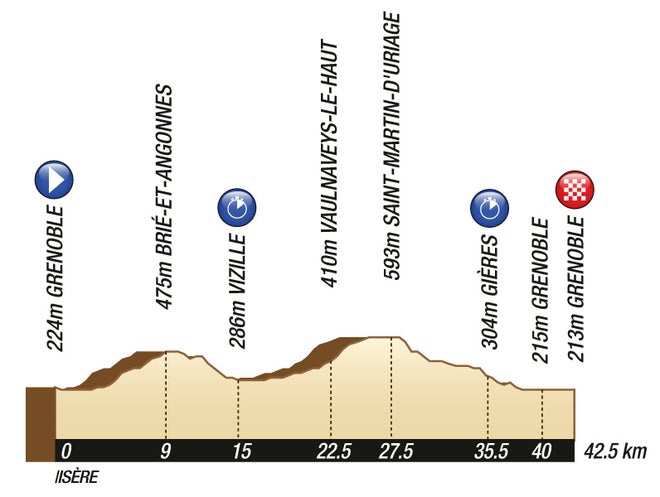
July 24 Stage 21: Créteil to Paris (Champs-Élysées), 95km (59 miles)
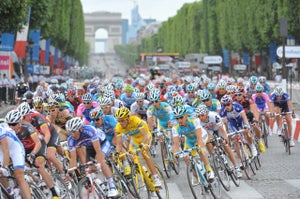
For the first time, rather than traveling by high-speed train, the riders will take a chartered jetliner on the final morning (from Grenoble to Orly Airport) to reach the start of stage 21 in Créteil. The early kilometers of the ultra-short stage will see the usual slow procession as photographers get shots of the yellow jersey sipping champagne at his team car before the speed picks up for the eight laps and 50km of racing around the traditional circuit up and down the Champs-Élysées and around the Tuileries Gardens.
THE SCOOP: No time bonuses are awarded at this Tour, so there are unlikely to be any changes in the final classification, but look for fireworks in the sprinters’ green-jersey competition. There’ll be a big intermediate sprint on the fourth lap as well as the final dash to the line, 35km later.
OVERALL RATING: *
